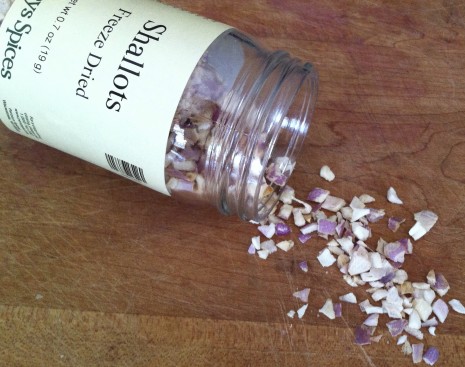KITCHEN SYNC: FREEZE-DRIED SHALLOTS
The shallot is a workhorse of the restaurant kitchen. It’s reliable and available year-round, and its flavor—delicate, nuanced, and intense all at the same time—gives finesse to dishes that range from classic French sauces (beurre blanc, bordelaise, mignonette) to the seasoning pastes and hành phi, the crisp caramelized shallots that add depth and richness to many Southeast Asian dishes. It’s a chef’s stealth ingredient, in other words—and one that has, in the United States, happily migrated from restaurants and luxurious little specialty foods shops to farmers markets and supermarket bins, where those of us who cook at home can easily get our hands on them.
Except when we can’t. If you don’t happen to live close to a market that carries fresh shallots, or if those you come across are soft in spots, withered, or moldy inside, you are plumb out of luck. Especially if you are devoted to homemade shallot vinaigrettes, this is a hardship—I, for one, really miss that suave, rounded sweetness if it’s not there.
Enter freeze-dried shallots from Wisconsin-based Penzeys Spices. I discovered this genius product through my friend and former Gourmet colleague Zanne Stewart, who has a flair for sussing out culinary shortcuts that don’t sacrifice quality. Even if you happen to have shallots at home, “there’s no rotting, no fiddly peeling,” Zanne said. “My salad dressing ALWAYS has them as a base. About a tablespoon of them, a couple of tablespoons Moscatel wine vinegar to rehydrate them, then mustard, salt, extra-virgin olive oil. The vinegar turns them pink and tender, and they brighten every salad.”
A bottle of freeze-dried shallots is extremely portable, which means it can travel to a weekend party or ski or beach house with ease. During this snowbound winter, I’ve relied on the shallots more and more: They make a great addition to almost any marinade, and can be rehydrated in a little water, drained well, then sautéed and added to mashed potatoes or an omelet.
I’ve also been experimenting with Southeast Asian–style crisp shallots. As usual, Zanne was a few steps ahead of me, although after reading her caveats, I don’t feel so bad about my first attempts, which were more along the lines of sacrificial burnt offerings.
“First, I set a fine sieve over a glass jar in the sink,” she recounted in an email earlier today. “Then I put about a quarter inch of (organic) canola in a small skillet with enough of the dried shallots to cover the bottom. Next, I heat the oil over moderate heat and keep an eagle eye on the shallots. No diversions permitted, because the instant you detect a golden tinge to a few of the shallots, you have to lift the pan from the heat and IMMEDIATELY (did I say, immediately?) pour into the sieve. The shallots are such tiny bits that they burn before you know it, in fact, right in front of your eyes. If all goes well, and, as I said, it doesn’t always, you get golden shallots to spread on several layers of paper towels and then sprinkle with salt. I use them like crazy on soups, in salads, you name it.”
This is a two-fer recipe, for the aromatic shallot oil that’s a byproduct of this venture goes into the refrigerator for another day. And even if crisp-fried shallots do belong in the “Attention Must Be Paid” section of your recipe file, they are worth it. You can stir them into bread crumbs for a pasta topping, or sprinkle them over a steak or burger. You can embellish a stir-fry, Thai curry, or plain-old steamed green beans. They add texture to a creamy soup such as winter squash or sweet potato, and enliven soups that run the risk of being stodgy—lentil, for instance, or split pea or black bean. Or you can simply eat spoonfuls of them when no one is looking.
Posted: February 25th, 2014 under cooking, Gourmet magazine, kitchen sync, pantry.


